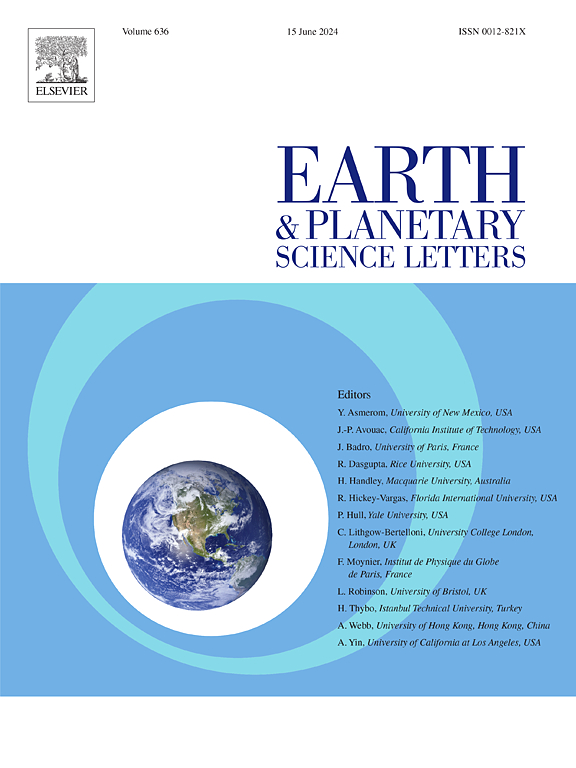探索俯冲带上板块断层再活化的摩擦特性:智利北部的阿塔卡马断层系统
IF 4.8
1区 地球科学
Q1 GEOCHEMISTRY & GEOPHYSICS
引用次数: 0
摘要
2010 年毛勒地震和 2011 年东北-冲地震表明,休眠的上板块断层可以在大地壳滑动后通过板块边缘松弛重新激活为正常断层。然而,这类断层的再活化机制尚未得到探索。为了更好地了解这些机制,我们收集了智利北部阿塔卡马断层系统断层段的断层岩芯样本。取样的断层段具有第四纪重新活化为正常断层的明显形态证据。我们进行了实验室实验,以测量断层强度、稳定性和动态削弱。我们考虑进行低速试验,通过双向剪切设备探索摩擦强度和摩擦的速度依赖性;ii)高速试验,通过旋转剪切设备研究地震速度下的摩擦特性。实验结果表明,断层岩心的摩擦强度较低,具有速度强化行为和较强的动态削弱。此外,通过逐步减小样品组件上的法向应力来模拟应力松弛的新型实验程序表明: 1:1.在富含绿泥石的沟槽中,蠕变加速,动态减弱;2. 在富含伊利石的断层沟槽中,振荡滑动。将我们的实验观察结果推断到自然条件下,我们得出结论:在俯冲地震周期的震间阶段,稳定的滑动是有利的,而在共震和震后阶段,不稳定的滑动是有利的。后者是在板块边缘从震间压缩向同震和震后拉伸转变的过程中,通过法向应力的降低而发生的。本文章由计算机程序翻译,如有差异,请以英文原文为准。
Exploring frictional properties of upper plate fault reactivation in subduction zones: The Atacama Fault System in northern Chile
The Maule 2010 and Tohoku-Oki 2011 earthquakes demonstrated how dormant upper plate faults can be reactivated as normal faults by plate margin relaxation following megathrust slip. However, the reactivation mechanisms of these types of faults are yet unexplored. To provide a better understanding of these mechanisms, we collected fault core samples from fault segments of the Atacama Fault System in northern Chile. The sampled fault segments have clear morphological evidence of Quaternary reactivation as normal fault. We performed laboratory experiments to measure the fault strength, stability and dynamic weakening. We consider low-velocity tests for exploring the frictional strength and velocity dependence of friction via a double-direct shear apparatus and ii) high-velocity tests for investigating the frictional properties at seismic velocities via a rotary shear apparatus. The experiments revealed that fault cores have low frictional strength, velocity-strengthening behaviour and strong dynamic weakening. Additionally, a novel experimental procedure that simulates stress relaxation by stepwise reducing of the normal stress on the sample assembly showed: 1. Accelerating creep towards dynamic weakening in chlorite-rich gouges and 2. oscillatory sliding in fault gouges enriched in illite. By extrapolating our experimental observations to natural conditions, we conclude that stable sliding is favoured during the interseismic phase of the subduction earthquake cycle, whereas unstable sliding is favoured during the coseismic and postseismic phases. The latter occurs via normal stress reduction during the shift from interseismic compression to co- and postseismic tension at the plate margin.
求助全文
通过发布文献求助,成功后即可免费获取论文全文。
去求助
来源期刊

Earth and Planetary Science Letters
地学-地球化学与地球物理
CiteScore
10.30
自引率
5.70%
发文量
475
审稿时长
2.8 months
期刊介绍:
Earth and Planetary Science Letters (EPSL) is a leading journal for researchers across the entire Earth and planetary sciences community. It publishes concise, exciting, high-impact articles ("Letters") of broad interest. Its focus is on physical and chemical processes, the evolution and general properties of the Earth and planets - from their deep interiors to their atmospheres. EPSL also includes a Frontiers section, featuring invited high-profile synthesis articles by leading experts on timely topics to bring cutting-edge research to the wider community.
 求助内容:
求助内容: 应助结果提醒方式:
应助结果提醒方式:


